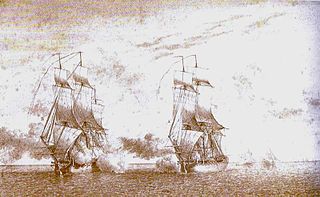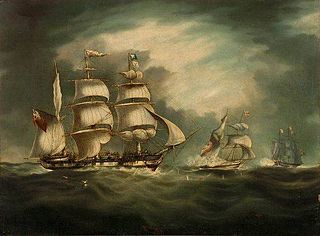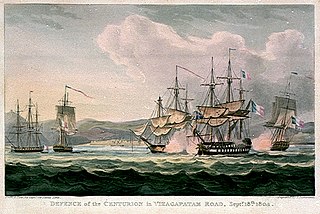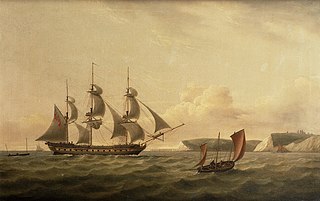Related Research Articles
Nine ships of the Royal Navy have been named HMS Amazon, after the mythical female warriors.

Charles-Alexandre Léon Durand, Comte de Linois was a French admiral who served in the French Navy during the reign of Napoleon Bonaparte. He commanded the combined Franco-Spanish fleet during the Algeciras Campaign in 1801, winning the First Battle of Algeciras before losing the Second Battle of Algeciras. He then led an unsuccessful campaign against British trade in the Indian Ocean and South China Sea in 1803, being defeated by a harmless fleet of the East India Company during the Battle of Pulo Aura and ending his cruise and sea-going career being bested in battle by John Warren in the action of 13 March 1806. Following the Bourbon restoration, Linois was appointed Governor of Guadeloupe. He supported Napoleon during the Hundred Days and so, on his return to France, he was forced to resign and was court martialled. Although acquitted, he was placed in retirement and never served again.

Belle Poule was a French frigate of the Dédaigneuse class, designed by Léon-Michel Guignace. She is most famous for her duel with the British frigate HMS Arethusa on 17 June 1778, which began the French involvement in the American War of Independence.

HMS Belle Poule was a Royal Navy fifth-rate frigate, formerly Belle Poule, a Virginie-class frigate of the French Navy that had been built by the Crucy family's shipyard at Basse-Indre to a design by Jacques-Noël Sané. She was launched on 17 April 1802, and saw active service in the East. In 1806 a British squadron under Sir John Borlase Warren captured her off La Palma in the Canary Islands. The Admiralty commissioned her into the Royal Navy as HMS Belle Poule. She was sold in 1816.
Two ships of the Royal Navy have borne the name HMS Belle Poule, from the French meaning Beautiful Chicken:

Aréthuse was a French frigate, launched in 1757 during the Seven Years' War. She was captured by the Royal Navy in 1759 and became the fifth-rate HMS Arethusa. She remained in Royal Navy service for twenty years until she was wrecked after being badly damaged in battle.

Rear-Admiral Sir Michael Seymour, 1st Baronet KCB was an officer of the Royal Navy. He served during the French Revolutionary and the Napoleonic Wars, eventually rising to the rank of rear-admiral.

Jean-Jacques Rousseau was a Téméraire class 74-gun ship of the line of the French Navy, active during the French Directory, French Consulate and First French Empire. Renamed Marengo in 1802, she took part in Linois' operations in the Indian Ocean before her capture by the Royal Navy.

Var was a corvette of the French Navy, launched in 1806 as the name-ship of her class of flutes. She served as a storeship until the British captured her in 1809. She became the transport HMS Chichester, and was wrecked in 1811.

Linois's expedition to the Indian Ocean was a commerce raiding operation launched by the French Navy during the Napoleonic Wars. Contre-Admiral Charles-Alexandre Durand Linois was ordered to the Indian Ocean in his flagship Marengo in March 1803 accompanied by a squadron of three frigates, shortly before the end of the Peace of Amiens. When war between Britain and France broke out in September 1803, Marengo was at Pondicherry with the frigates, but escaped a British squadron sent to intercept it and reached Isle de France. The large distances between naval bases in the Indian Ocean and the limited resources available to the British commanders in the region made it difficult to concentrate sufficient forces to combat a squadron of this size, and Linois was subsequently able to sustain his campaign for three years. From Isle de France, Linois and his frigates began a series of attacks on British commerce across the Eastern Indian Ocean, specifically targeting the large convoys of East Indiamen that were vital to the maintenance of trade within the British Empire and to the British economy. Although he had a number of successes against individual merchant ships and the small British trading post of Bencoolen, the first military test of Linois squadron came at the Battle of Pulo Aura on 15 February 1804. Linois attacked the undefended British China Fleet, consisting of 16 valuable East Indiamen and 14 other vessels, but failed to press his military superiority and withdrew without capturing a single ship.

The action of 13 March 1806 was a naval engagement of the Napoleonic Wars, fought when a British and a French squadron met unexpectedly in the mid-Atlantic. Neither force was aware of the presence of the other prior to the encounter and were participating in separate campaigns. The British squadron consisted of seven ships of the line accompanied by associated frigates, led by Rear-Admiral Sir John Borlase Warren, were tasked with hunting down and destroying the French squadron of Contre-Admiral Jean-Baptiste Willaumez, which had departed Brest for raiding operations in the South Atlantic in December 1805, at the start of the Atlantic campaign of 1806. The French force consisted of one ship of the line and one frigate, all that remained of Contre-Admiral Charles-Alexandre Durand Linois' squadron that had sailed for the Indian Ocean in March 1803 during the Peace of Amiens. Linois raided British shipping lanes and harbours across the region, achieving limited success against undefended merchant ships but repeatedly withdrawing in the face of determined opposition, most notably at the Battle of Pulo Aura in February 1804. With his stores almost exhausted and the French ports east of the Cape of Good Hope that could have offered him replenishment eliminated, Linois decided to return to France in January 1806, and by March was inadvertently sailing across the cruising ground of Warren's squadron.

The Atalante was a 40-gun Virginie-class frigate of the French Navy, launched in 1802.

HMS Amazon was a 38-gun fifth-rate Amazon-class frigate of the Royal Navy. She served during the French Revolutionary and Napoleonic Wars under several notable naval commanders and played a key role in the Battle of Copenhagen under Edward Riou, who commanded the frigate squadron during the attack. After Riou was killed during the battle, command briefly devolved to John Quilliam. Quilliam made a significant impression on Horatio Nelson, who appointed Quilliam to serve on the flagship HMS Victory. Amazon passed to William Parker, who continued the association with Nelson with service in the Mediterranean and participation in the chase to the West Indies during the Trafalgar Campaign. Amazon went on to join Sir John Borlase Warren's squadron in the Atlantic and took part in the defeat of Charles-Alexandre Léon Durand Linois's forces at the action of 13 March 1806. During the battle, she hunted down and captured the 40-gun frigate Belle Poule.
Président was a 40-gun frigate of the Gloire class in the French Navy, built to an 1802 design by Pierre-Alexandre Forfait. She served with the French Navy from her completion in 1804 until late 1806 when the Royal Navy captured her. Thereafter, she served as HMS President. In 1815 the Navy renamed her Piemontaise, but then broke her up in December.

Several Royal Navy ships have borne the name HMS Proserpine:
Ten ships of the Royal Navy have borne the name HMS Laurel. Another was planned but never completed. The first British ship of the name served in the Commonwealth navy. All were named after the plant family Lauraceae.

The action of 17 June 1778 also known as the Fight of Belle Poule and Arethusa was a minor naval action that took place off the coast of France between British and French frigates. The action was widely celebrated by both France and Great Britain and was the first between the two naval forces during the American Revolutionary War before a formal declaration of war was even announced.
Brunswick was launched in 1792 as an East Indiaman for the British East India Company (EIC). She made five complete voyages for the EIC before the French captured her in 1805. Shortly thereafter she wrecked at the Cape of Good Hope.